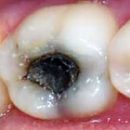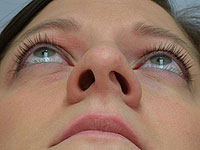«Chronic tonsillitis? Who has no», - Such a relation to the disease on the one hand indicates its wide distribution, on the other - on carelessly to your health. About chronic tonsillitis as a dangerous disease we will tell in this article.
Content
- Why he arises?
- How chronic tonsillitis is exacerbated?
- Forms of chronic tonsillitis
- How to treat chronic tonsillitis?
 Chronic tonsillitis, or simply angina, is called a long-term inflammation of the sky almonds, which occurs with the periods of cloud and exacerbations and characterized by the development of the infectious and toxic and infectious-allergic reaction of the body.
Chronic tonsillitis, or simply angina, is called a long-term inflammation of the sky almonds, which occurs with the periods of cloud and exacerbations and characterized by the development of the infectious and toxic and infectious-allergic reaction of the body.
Chronic tonsillitis — Extremely common disease, almost every person can detect certain signs, especially in winter. Most knows: In order not to get angina, you need to harden and do not drink cold drinks, ease the throat pain will help tea with raspberries and lollipops with antiseptic. We appeal to the doctor in exceptional cases when the disease interferes with studies or work and a hospital sheet is needed or when tonsillitis develops atypically and need medical care.
Why he arises?
Chronic tonsillitis is the outcome of acute inflammation of the almonds caused by various bacteria, viruses and even mushrooms. In 30% of cases in almonds in patients with children, beta hemolytic streptococcus group A, which causes global restructuring of the immune system, provoking the development of autoimmune diseases such as rheumatism and glomerulonephritis. In adults, Streptococcus is detected only in 10% of cases, the streptococci of other groups and other microorganisms are more common.
If the chronic tonsillituit is preceded by an acute throat, one can clearly indicate the day of the disease, but in most cases the alarg is masked by other, more painful symptoms of ARVI, adenoiditis, or periodontal symptoms, then the disease develops imperceptibly, and almond changes detects only a doctor during inspection.
How chronic tonsillitis is exacerbated?
What do you need to know? First of all, in time to take preventive measures and choose the right treatment, which will avoid complications: rheumatism, endocarditis and glomerulonephritis.
The exacerbation of chronic tonsillitis contribute to the overeaching, activation of chronic infection, the decrease in immunity, including as a result of diseases of various organs, distant from the pharynx. The appearance of light throat pain in swallowing testifies to the approaching danger, but with the timely use of antiseptics, the irrigation of the nasopharynk, rinse the throat process can be stopped. In the worst case, inevitably full aggravation of tonsillitis.
The aggravation of chronic tonsillitis can occur in two forms: in the first case it resembles acute tonsillitis, the second is developing paratronzillar abscess.
The aggravation by type of acute tonsillitis is characterized by an increase in body temperature to 38–39 OS, chills, weakness, fragmentation in the body, heaviness in the head, sore throat, difficulty swallowing. Submandibular lymph nodes increase, become dense and painful. Inflamed almonds increase in size, become red, grainy, on their surfaces are noticeable extended, filled with pus lacuna.
Paratonzillar abscess or, the accumulation of pus in the fiber, surrounding the almonds, is first similar to the usual angina, but after a few days, when relief, throat pain, the opposite, increases, increases the edema of the pharynx, it makes it difficult to swallowing up to the full impossibility of receiving even liquid Food. Due to severe pain, do not open the mouth, in the submandibular region they are tightly painted painful enlarged lymph nodes.
Paratonzillar abscess — Dangerous disease that can be complicated by a breakthrough in the neighboring areas, the development of blood and infectious-toxic shock.
Forms of chronic tonsillitis
 Simple chronic tonsillitis — initial stage of the disease. For him, not so much frequent exacerbations are typical of the presence of local signs of chronic inflammation of almonds: enlarged, filled with follicles, pliers in lacunas, redness of the palake and the formation of adhesions between them and almonds.
Simple chronic tonsillitis — initial stage of the disease. For him, not so much frequent exacerbations are typical of the presence of local signs of chronic inflammation of almonds: enlarged, filled with follicles, pliers in lacunas, redness of the palake and the formation of adhesions between them and almonds.
The toxic-allergic shape of chronic tonsillitis of the first type is developing when engaging in the pathological process of the immune system. It is characterized by periodic exacerbations arising after each ORVI, manifested by general intoxication, weakness, malaise, increasing temperature, pain in the joints and heart and leaving after themselves «tail» in the form of various functional disorders.
With the toxic-allergic form of the second type, the symptoms of exacerbations are also expressed brighter, pain in the heart is reflected on the ECG in the form of functional disorders and changes in the rhythm, and these violations are preserved and in the period of lull of the disease. Even during remission, there is a subfebrile temperature, disorders in the work of the liver, kidneys, joints and other organs are revealed. Rheumatism can develop, endocarditis in combination with heart defects, infectious arthritis, glomerulonephritis, prostatitis, thyroiditis and meningitis.
Thus, chronic tonsillitis — not a harmless illness whose symptoms can be ignored. This is an infectious allergic attack on the whole body, requiring active counterattack.
How to treat chronic tonsillitis?
The basis of treatment is antibacterial therapy, it is impossible to cure tonsillitis without it. Antibiotics are used both for overall therapy and locally, in the form of spraying, together with the rinse of the throat with antiseptics, infused and decoctions of medicinal plants and resorption of candies.
When exacerbating tonsillitis, bedding is needed, it allows you to reduce the burden on the body and the cardiovascular system. Meals involves a gentle diet, eliminating the use of too cold and hot dishes, coarse, sharp, acidic, sweet and salty food, smoked and marinades. To reduce pain in the throat and active elimination of toxins from the body, a rich warm drink is shown.
In order to combat fever, antipyretic drugs are used from a group of non-steroidal anti-inflammatory funds. To reduce body allergization and reduce the likelihood of autoamellergia, antihistamines are used to enhance immune protection — Immunostimulants, antioxidants.
The formation of paratonzillural abscess is an indication for surgical treatment, that is, the openings of the gland and drainage of its cavity to ensure pus outflow. After surgery, treatment is carried out in the same way as in case of a simple exacerbation.
The conservative therapy of chronic tonsillitis is carried out only in case of exacerbation with a simple form, with a toxic-allergic form of the first type; With a second-type toxico-allergic form after removal of symptoms of exacerbation shows the removal of almonds — tonsilectomy.









